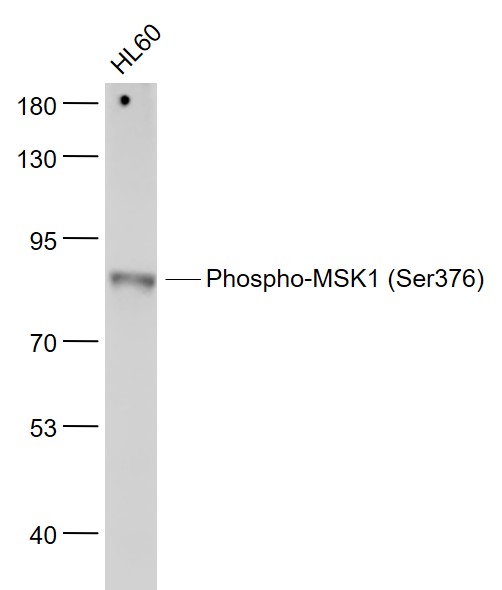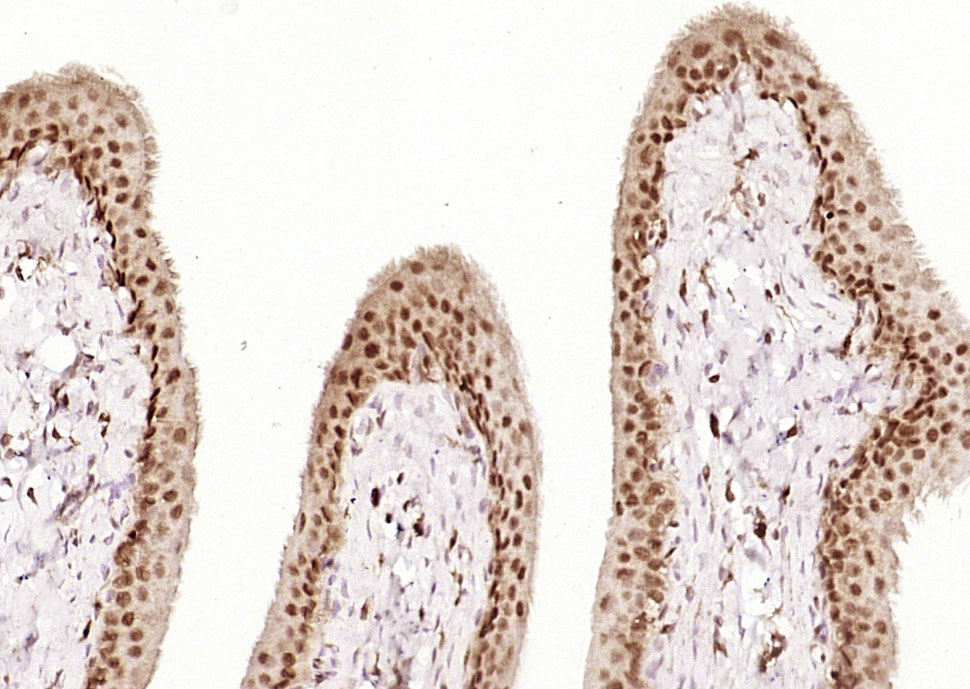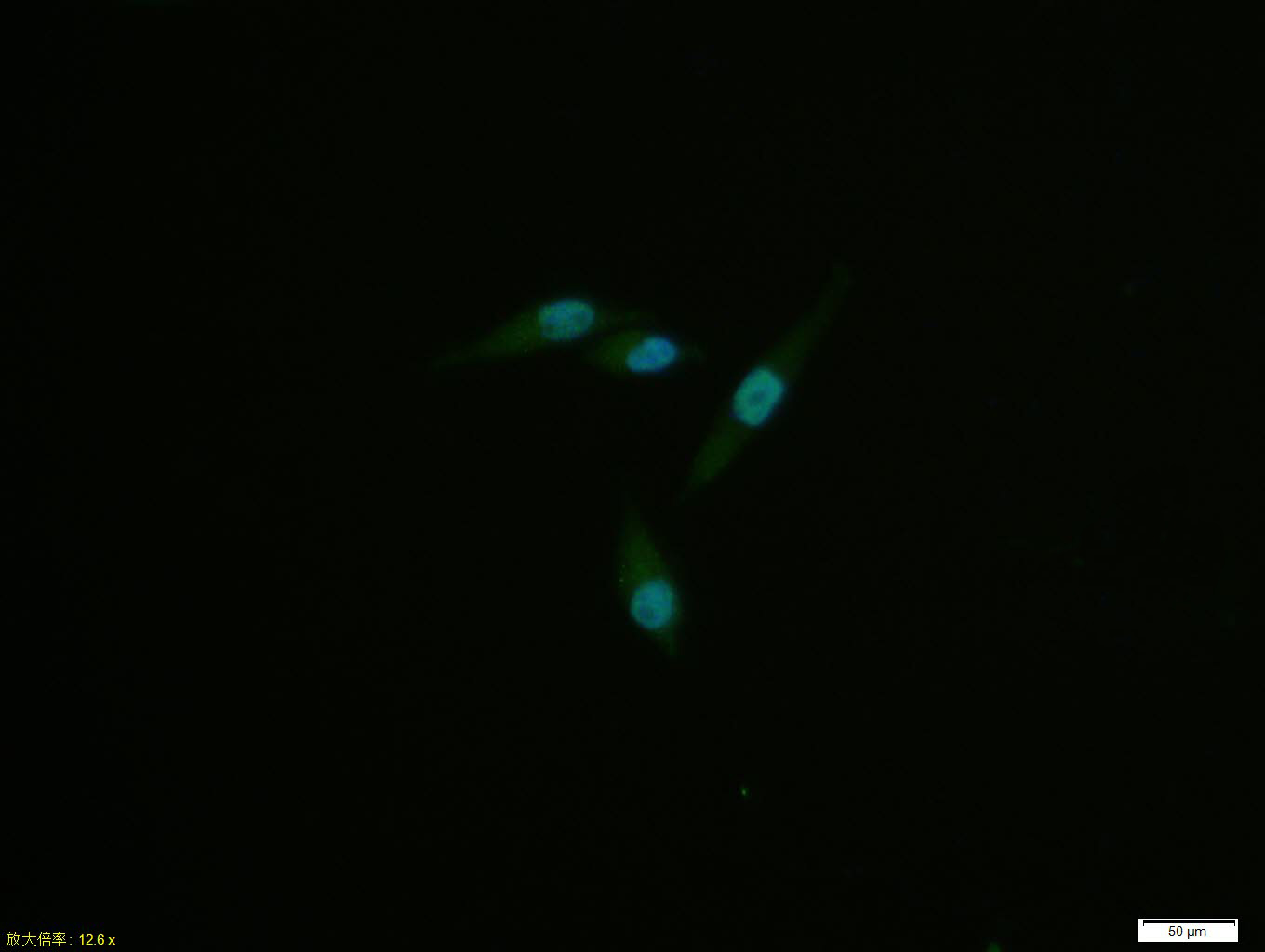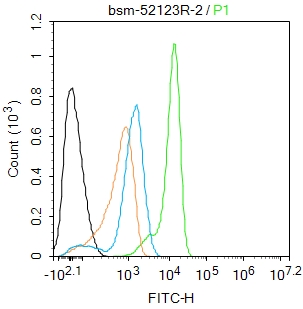
Rabbit Anti-Phospho-MSK1 (Ser376)antibody
MSK1 (phospho S376); MSK1 (Phospho Ser376); 90 kDa ribosomal protein S6 kinase 5; EC 2.7.11.1; KS6A5_HUMAN; MGC1911; Mitogen and stress activated protein kinase 1; MSPK1; Nuclear Mitogen And Stress Activated Protein Kinase 1; Nuclear mitogen- and stress-a
View History [Clear]
Details
Product Name Phospho-MSK1 (Ser376) Chinese Name 磷酸化MSK1Recombinant rabbit monoclonal anti Alias MSK1 (phospho S376); MSK1 (Phospho Ser376); 90 kDa ribosomal protein S6 kinase 5; EC 2.7.11.1; KS6A5_HUMAN; MGC1911; Mitogen and stress activated protein kinase 1; MSPK1; Nuclear Mitogen And Stress Activated Protein Kinase 1; Nuclear mitogen- and stress-activated protein kinase 1; Ribosomal protein S6 kinase 90kD polypeptide 5; Ribosomal protein S6 kinase 90kDa; Ribosomal protein S6 kinase 90kDa polypeptide 5; Ribosomal Protein S6 Kinase Alpha 5; Ribosomal protein S6 kinase alpha-5; RLPK; RPS6KA5; RSK Like Protein Kinase; RSK-like protein kinase; RSKL; S6K alpha 5; S6K-alpha-5. Research Area Cell biology immunology Chromatin and nuclear signals Signal transduction transcriptional regulatory factor Kinases and Phosphatases The new supersedes the old Epigenetics Immunogen Species Rabbit Clonality Monoclonal Clone NO. 11A1 React Species Human, Rat, Applications WB=1:500-2000 IHC-P=1:20-200 IHC-F=1:20-200 Flow-Cyt=2ug/Test ICC=1:100 IF=1:20-200 (Paraffin sections need antigen repair)
not yet tested in other applications.
optimal dilutions/concentrations should be determined by the end user.Theoretical molecular weight 90kDa Cellular localization The nucleus cytoplasmic Form Liquid Concentration 1mg/ml immunogen KLH conjugated synthesised phosphopeptide derived from human MSK1 around the phosphorylation site of Ser376: GY(p-S)FV Lsotype IgG Purification affinity purified by Protein A Buffer Solution 0.01M TBS(pH7.4) with 1% BSA, 0.03% Proclin300 and 50% Glycerol. Storage Shipped at 4℃. Store at -20 °C for one year. Avoid repeated freeze/thaw cycles. Attention This product as supplied is intended for research use only, not for use in human, therapeutic or diagnostic applications. PubMed PubMed Product Detail MSK1 is a mitogen and stress activated protein kinase 1 which belongs to the AGC family of kinases and is related in structure to the ribosomal p70 S6 kinase subfamily. MSK1 can be activated by ERK1/2 and SAPK2/p38 MAP kinase. It is also known to be required for the phosphorylation of CREB, ATF1 H3 and HMG14 in response to mitogen and stress. Similar to RSK, MSK1 contains two kinase domains (N term and a C term). Once phosphorylated on Thr581 and Ser360 by ERK1/2 and SAPK2/p38, MSK1 autophosphorylate on at least 5 sites. Of these autophosphorylation sites Ser212 and Ser376 get phosphorylated by the C terminal kinase domain of MSK1 which is essential for the catalytic activity of the N terminal kinase domain.
Function:
Serine/threonine-protein kinase that is required for the mitogen or stress-induced phosphorylation of the transcription factors CREB1 and ATF1 and for the regulation of the transcription factors RELA, STAT3 and ETV1/ER81, and that contributes to gene activation by histone phosphorylation and functions in the regulation of inflammatory genes. Phosphorylates CREB1 and ATF1 in response to mitogenic or stress stimuli such as UV-C irradiation, epidermal growth factor (EGF) and anisomycin. Plays an essential role in the control of RELA transcriptional activity in response to TNF and upon glucocorticoid, associates in the cytoplasm with the glucocorticoid receptor NR3C1 and contributes to RELA inhibition and repression of inflammatory gene expression. In skeletal myoblasts is required for phosphorylation of RELA at 'Ser-276' during oxidative stress. In erythropoietin-stimulated cells, is necessary for the 'Ser-727' phosphorylation of STAT3 and regulation of its transcriptional potential. Phosphorylates ETV1/ER81 at 'Ser-191' and 'Ser-216', and thereby regulates its ability to stimulate transcription, which may be important during development and breast tumor formation. Directly represses transcription via phosphorylation of 'Ser-1' of histone H2A. Phosphorylates 'Ser-10' of histone H3 in response to mitogenics, stress stimuli and EGF, which results in the transcriptional activation of several immediate early genes, including proto-oncogenes c-fos/FOS and c-jun/JUN. May also phosphorylate 'Ser-28' of histone H3. Mediates the mitogen- and stress-induced phosphorylation of high mobility group protein 1 (HMGN1/HMG14). In lipopolysaccharide-stimulated primary macrophages, acts downstream of the Toll-like receptor TLR4 to limit the production of pro-inflammatory cytokines. Functions probably by inducing transcription of the MAP kinase phosphatase DUSP1 and the anti-inflammatory cytokine interleukin 10 (IL10), via CREB1 and ATF1 transcription factors. Plays a role in neuronal cell death by mediating the downstream effects of excitotoxic injury.
Subunit:
Forms a complex with either MAPK1/ERK2 or MAPK3/ERK1 in quiescent cells which transiently dissociates following mitogenic stimulation. Also associates with MAPK14/p38-alpha. Activated RPS6KA5 associates with and phosphorylates the NF-kappa-B p65 subunit RELA. Interacts with CREBBP and EP300.
Subcellular Location:
Nucleus. Cytoplasm. Note=Predominantly nuclear. Exported into cytoplasm in response to glucocorticoid.
Tissue Specificity:
Widely expressed with high levels in heart, brain and placenta. Less abundant in lung, kidney and liver.
Post-translational modifications:
Ser-376 and Thr-581 phosphorylation is required for kinase activity. Ser-376 and Ser-212 are autophosphorylated by the C-terminal kinase domain, and their phosphorylation is essential for the catalytic activity of the N-terminal kinase domain. Phosphorylated at Ser-360, Thr-581 and Thr-700 by MAPK1/ERK2, MAPK3/ERK1 and MAPK14/p38-alpha. Autophosphorylated at Ser-750, Ser-752 and Ser-758 by the N-terminal kinase domain.
Similarity:
Belongs to the protein kinase superfamily. AGC Ser/Thr protein kinase family. S6 kinase subfamily.
Contains 1 AGC-kinase C-terminal domain.
Contains 2 protein kinase domains.
SWISS:
O75582
Gene ID:
9252
Database links:Entrez Gene: 9252 Human
Entrez Gene: 73086 Mouse
Omim: 603607 Human
SwissProt: O75582 Human
SwissProt: Q8C050 Mouse
Unigene: 510225 Human
Unigene: 220417 Mouse
Unigene: 392855 Mouse
Unigene: 8940 Rat
Product Picture
HL60(Human) Cell Lysate at 30 ug
Primary: Anti- Phospho-MSK1 (Ser376) (SLM-52123R) at 1/1000 dilution
Secondary: IRDye800CW Goat Anti-Rabbit IgG at 1/20000 dilution
Predicted band size: 90 kD
Observed band size: 90 kD
Paraformaldehyde-fixed, paraffin embedded (rat bladder); Antigen retrieval by boiling in sodium citrate buffer (pH6.0) for 15min; Block endogenous peroxidase by 3% hydrogen peroxide for 20 minutes; Blocking buffer (normal goat serum) at 37°C for 30min; Antibody incubation with (Phospho-MSK1 (Ser376)) Polyclonal Antibody, Unconjugated (SLM-52123R) at 1:200 overnight at 4°C, followed by operating according to SP Kit(Rabbit) (sp-0023) instructionsand DAB staining.SH-SY5Y cell; 4% Paraformaldehyde-fixed; Triton X-100 at room temperature for 20 min; Blocking buffer (normal goat serum, C-0005) at 37°C for 20 min; Antibody incubation with (Phospho-MSK1 (Ser376)) monoclonal Antibody, Unconjugated (SLM-52123R) 1:100, 90 minutes at 37°C; followed by a conjugated Goat Anti-Rabbit IgG antibody at 37°C for 90 minutes, DAPI (blue, C02-04002) was used to stain the cell nuclei.Blank control: U-937.
Primary Antibody (green line): Rabbit Anti-Phospho-MSK1 (Ser376)antibody (SLM-52123R)
Dilution:2ug/Test;
Secondary Antibody : Goat anti-rabbit IgG-FITC
Dilution: 0.5ug/Test.
Protocol
The cells were fixed with 4% PFA (10min at room temperature)and then permeabilized with 90% ice-cold methanol for 20 min at -20℃.The cells were then incubated in 5%BSA to block non-specific protein-protein interactions for 30 min at room temperature .Cells stained with Primary Antibody for 30 min at room temperature. The secondary antibody used for 40 min at room temperature. Acquisition of 20,000 events was performed.
References (0)
No References
Bought notes(bought amounts latest0)
No one bought this product
User Comment(Total0User Comment Num)
- No comment






 +86 571 56623320
+86 571 56623320
 +86 18668110335
+86 18668110335

